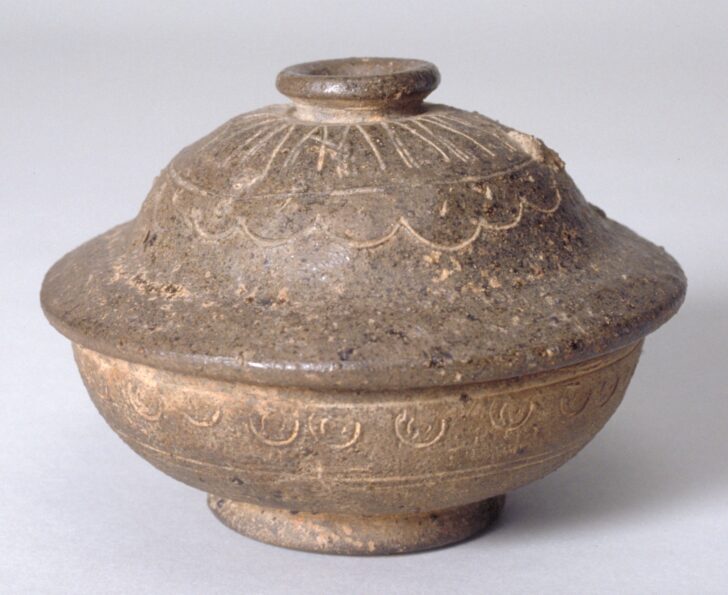Cinerary urn with triangular circle-and-dot design
Korean

Description
Gallery Rotations Fall 2012
Cinerary urn with triangular and
circle-and-dot design
Korea, Unified Silla period (668–935)
7th–8th century
Stoneware with stamped and incised decoration and natural ash glaze
Gift of Mrs. Caroline I. Plumer for the James Marshall Plumer Memorial Collection, 1973/2.36A&B
Buddhism spread throughout Korea during the fourth century,
and Koreans adopted the Buddhist practice of cremation.
Unglazed gray stoneware urns like these held ashes of the deceased. Sometimes the urns were placed inside granite containers before burial. Many similar urns have been unearthed in the vicinity of Gyeongju, the capital of Silla. Although modest in size, these funerary vessels have an intriguing shape. The horizontal stretch of the squat body is counterbalanced by the convex and concave curves of the lid, culminating in a pointed knob. One of the
knobs is button shaped. The other two knobs are in the shape
of a cintamani (wish-granting jewel), a Buddhist object that
has the power to shine even in darkness, thus symbolically enlightening the ignorant souls in its presence.
The stable, masculine form shows the pervasive influence of
Tang-ruled China, the staunch ally of Silla. But the designs—incised triangular shapes and impressed concentric circles
or impressed dots within partial circles—are characteristic
of Unified Silla decoration. This stamped decoration would
later contribute to the development of slip-inlaid decoration
on Goryeo celadon and Joseon Buncheong ware, which are on
view in this gallery.
Subject Matter:
This jar is designed to hold relics of the deceased.
Physical Description:
Stoneware jar with natural ash glaze and bell-shaped lid. Along the widest horizontal stretch of the base is an incised circle-and-dot design. A variation on this pattern also loops around the lid, topped by a line marking a ring along the surface of the lid, and incised lines extending outward from a button-shaped knob.
This is a dark gray, high-fired stoneware lidded bowl with a stamped design. The lid features a button-shaped knob at its center. Thinly incised lines encircle the upper part of the lid, dividing its surface into two segments. The inner segment is decorated with a triangular line design, whereas the outer segment is decorated with a design consisting of semicircles with dots inside, which border the inner segment. Sets of two thinly incised horizontal lines run around the section of the bowl immediately below the rim and the lower middle part of the body. A double semicircular design decorates the segment between these two sets of lines. The foot is short and thick and has a footring located on its outer side.
[Korean Collection, University of Michigan Museum of Art (2017) p. 80]
Usage Rights:
If you are interested in using an image for a publication, please visit https://umma.umich.edu/request-image/ for more information and to fill out the online Image Rights and Reproductions Request Form.